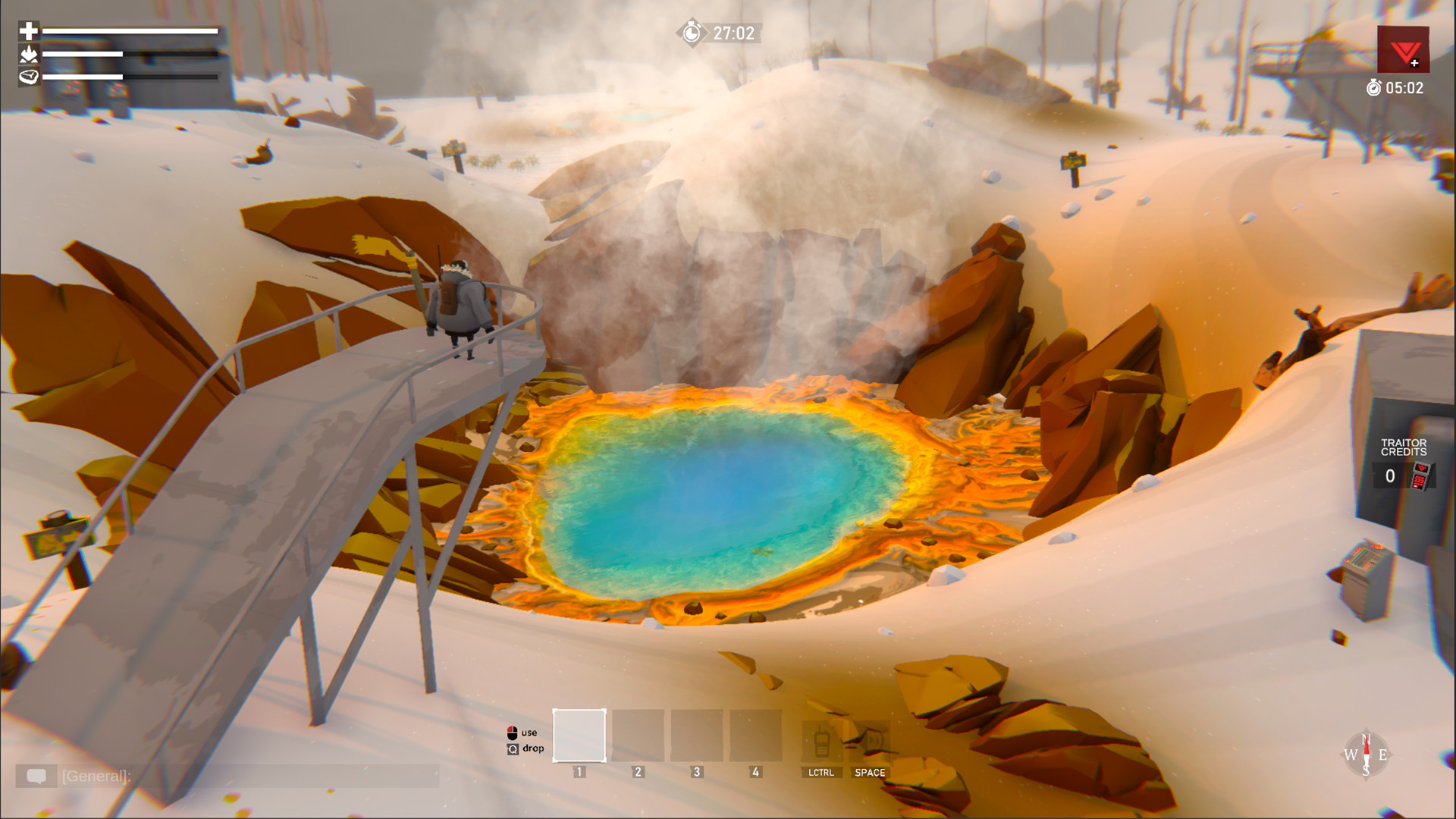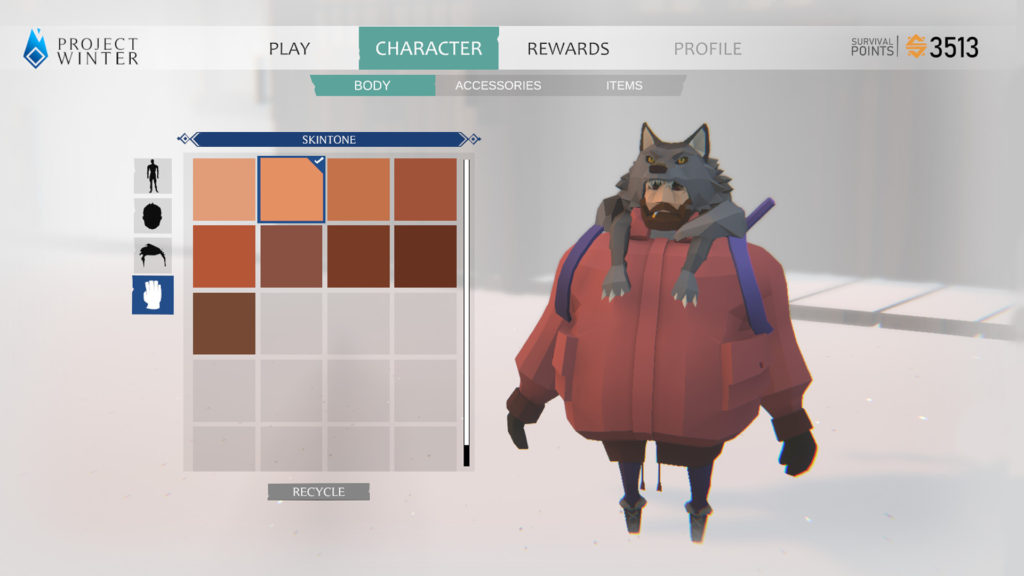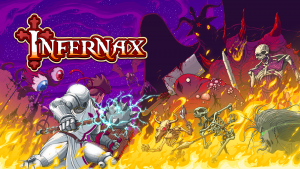
Other Ocean’s Project Winter can be described as a combination of a multiplayer survival game and the Garry’s Mod gamemode Trouble in Terrorist Town. The premise is simple enough, 8 players are trapped in a snowy area, trying to survive the frequent blizzards and hostile wildlife, and eventually repair enough infrastructure to call for an escape transport to gain their freedom – before a mega blizzard hits after 30 minutes. However, 2 of the players in the group are traitors, whose goal is to sabotage the rescue, draw suspicion on other survivors, and try to eliminate them when the opportunity is available. The survivors have the numbers advantage, but the traitors are unknown to the group and have ways of gaining special equipment to aid them in their task.
The cabin acts as the main hub for the players, and is located in the centre of the map. Players must manage health, warmth and hunger if they are to survive the game, and the cabin is key to all 3 of these. The cabin provides warmth to anyone inside it, and also holds the cooking station, crafting station, escape radio, storage container and exile box. The crafting and gathering systems are simple. Players can gather resources by hand, and if they choose, use some of them at the crafting station to create tools to speed up the gathering process. Resources can also be used to craft repair parts, guns, and traps. The cooking station works in a similar manner. Players can gather food out in the woods and eat it raw, or can choose to take it back to the cabin to cook it, which makes it yield more health and food intake when consumed. With a limited inventory space, the game becomes a balancing act of what to craft and hold onto, and what to drop. An important aspect of the cabin is the exile box. Players can vote to exile a player, and if enough votes are cast against them, they will be prevented from entering the cabin, robbing them of crafting opportunities and a free source of warmth. The radio can be activated to call for an escape once the infrastructure of the map has been fixed.

In order to fix the objectives, players must venture out across the map to find them, and ascertain what resources they will need in order to fix them. Communication is key, and the game has some interesting mechanics in this regard. There is VOIP to make communication easy, but this is proximity based, and the sound will slowly fade into silence as you go farther from the player who is talking. This means you can only keep an eye on the players who are near to you, making staying with a group vital to success. You can also craft radios of different colours, allowing you to communicate with players with a radio of the same colour, regardless of distance. Both of these mechanics work well in encouraging teamwork between the survivors (and traitors), as well as creating some genuine suspense as you are unaware of what may be happening with other groups on the map. Grouping up is also important to opening bunkers, will require multiple players to open, and hold lots of useful items, which can save a great deal of time trying to gather resources and craft repair equipment back at the cabin.
Once a player has found a piece of infrastructure on the map that needs repairing, they can send out a beacon to alert the other players to its location. The survivors must repair multiple pieces of equipment to call in their escape, which is where the traitor mechanics come into play. There are traitor crates scattered across the map, which contain traitor credits and pieces of gear to help them achieve their goal. These are only available to the traitors, but they make a loud noise when opened, and can give away a traitor if they are not careful. There are also traitor hatches, which allow them to move quickly across the map. A traitor with enough credits can sabotage a repaired piece of equipment, meaning the survivors must return to repair it in order to be able to escape. Traitors can adopt different tactics here. As survivors don’t like to travel alone for the risk of being picked off, this can cause players to have to spend time travelling across the map to fix the sabotaged equipment, rather than progressing with the overall task. This allows traitors to move back and forth, never allowing all the pieces of equipment to stay active unless they are properly guarded. They can also lay traps at a sabotaged station and ambush any survivors and kill them. A well prepared traitor can cause havoc to the survivor team if they do not coordinate properly, and cause them to lose simply by running out of time.
Whilst the mechanics of Project Winter are well implemented, there are a few issues which could be expected of an early access title. The game has a short tutorial video, as well as a written one explaining the basic mechanics of the game, but there are a few things absent from both that would have been worth mentioning. The game does not cover the objective radar, which is a piece of equipment that will point in the direction of an objective that requires fixing. This can vastly speed up the time to find an important objective in an otherwise large map (there is no map to speak of other than a compass at the top of the screen that shows you roughly what part of the map you are in). Objectives can either require fuel, mechanical scrap, or electronic scrap to fix. You will not know which type of part you will need until the objective is located, but new players may not realise that there are 3 different repair resources they may need to gather. The most notable thing missing from the tutorial is that player names are not shown above each person’s character model, and you have to press a button in order to make them visible. This is vital when trying to communicate if someone is a traitor, and should be made clear to new players. There are also a few minor issues with the gameplay. Picking up items off the ground can sometimes be awkward, especially when trying to pick up a specific items from a pile. The swing animations with the melee weapons can be somewhat awkward, and the AI pathing for the animals also needs some work (although the developers have noted this and have plans to improve this). The biggest current gameplay issue is that player models will appear behind certain terrain features on the map such as trees or rocks, which can make moving around difficult, or allow players to gain an unfair advantage by hiding where another player can’t see them.
Although there are a few minor gripes with certain mechanics not being explained effectively, and a small number of gameplay issues, they are certainly excusable for an Early Access title and could be easily fixed in later patches. Ultimately, Project Winter is a fun game that rewards skill based play and communication, and can create some epic moments when trying to bring about the final escape with your remaining survivors, or making your final attempt to stop them as a traitor.
Score: 8.2/10







